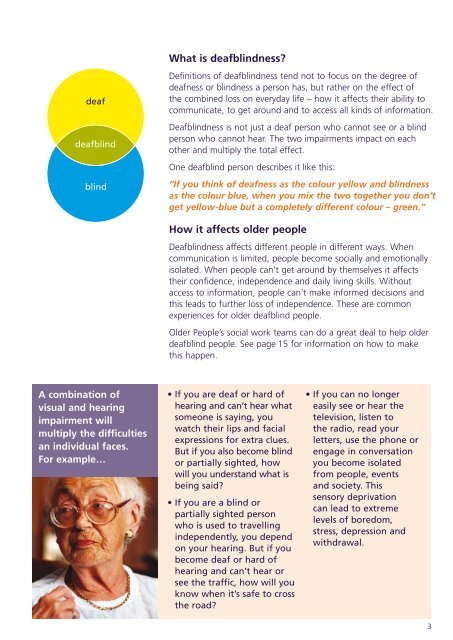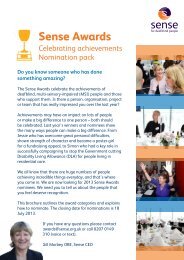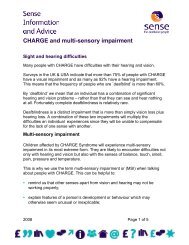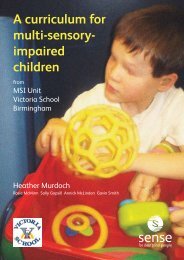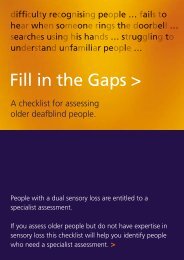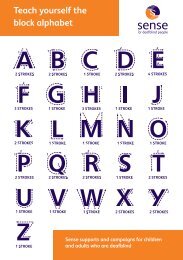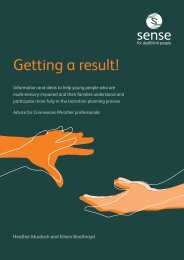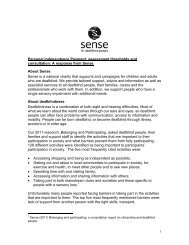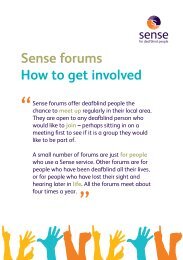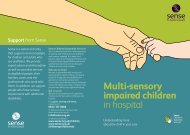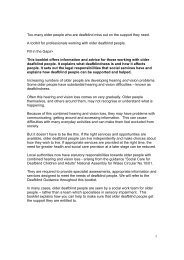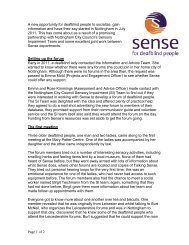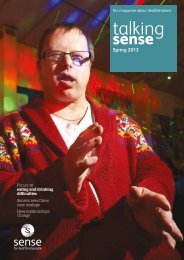Fill in the Gaps > Too many older people who are deafblind ... - Sense
Fill in the Gaps > Too many older people who are deafblind ... - Sense
Fill in the Gaps > Too many older people who are deafblind ... - Sense
You also want an ePaper? Increase the reach of your titles
YUMPU automatically turns print PDFs into web optimized ePapers that Google loves.
deafdeafbl<strong>in</strong>dbl<strong>in</strong>dWhat is deafbl<strong>in</strong>dness?Def<strong>in</strong>itions of deafbl<strong>in</strong>dness tend not to focus on <strong>the</strong> degree ofdeafness or bl<strong>in</strong>dness a person has, but ra<strong>the</strong>r on <strong>the</strong> effect of<strong>the</strong> comb<strong>in</strong>ed loss on everyday life – how it affects <strong>the</strong>ir ability tocommunicate, to get around and to access all k<strong>in</strong>ds of <strong>in</strong>formation.Deafbl<strong>in</strong>dness is not just a deaf person <strong>who</strong> cannot see or a bl<strong>in</strong>dperson <strong>who</strong> cannot hear. The two impairments impact on eacho<strong>the</strong>r and multiply <strong>the</strong> total effect.One deafbl<strong>in</strong>d person describes it like this:“If you th<strong>in</strong>k of deafness as <strong>the</strong> colour yellow and bl<strong>in</strong>dnessas <strong>the</strong> colour blue, when you mix <strong>the</strong> two toge<strong>the</strong>r you don’tget yellow-blue but a completely different colour – green.”How it affects <strong>older</strong> <strong>people</strong>Deafbl<strong>in</strong>dness affects different <strong>people</strong> <strong>in</strong> different ways. Whencommunication is limited, <strong>people</strong> become socially and emotionallyisolated. When <strong>people</strong> can’t get around by <strong>the</strong>mselves it affects<strong>the</strong>ir confidence, <strong>in</strong>dependence and daily liv<strong>in</strong>g skills. Withoutaccess to <strong>in</strong>formation, <strong>people</strong> can’t make <strong>in</strong>formed decisions andthis leads to fur<strong>the</strong>r loss of <strong>in</strong>dependence. These <strong>are</strong> commonexperiences for <strong>older</strong> deafbl<strong>in</strong>d <strong>people</strong>.Older People’s social work teams can do a great deal to help <strong>older</strong>deafbl<strong>in</strong>d <strong>people</strong>. See page 15 for <strong>in</strong>formation on how to makethis happen.A comb<strong>in</strong>ation ofvisual and hear<strong>in</strong>gimpairment willmultiply <strong>the</strong> difficultiesan <strong>in</strong>dividual faces.For example…• If you <strong>are</strong> deaf or hard ofhear<strong>in</strong>g and can’t hear whatsomeone is say<strong>in</strong>g, youwatch <strong>the</strong>ir lips and facialexpressions for extra clues.But if you also become bl<strong>in</strong>dor partially sighted, howwill you understand what isbe<strong>in</strong>g said?• If you <strong>are</strong> a bl<strong>in</strong>d orpartially sighted person<strong>who</strong> is used to travell<strong>in</strong>g<strong>in</strong>dependently, you dependon your hear<strong>in</strong>g. But if youbecome deaf or hard ofhear<strong>in</strong>g and can’t hear orsee <strong>the</strong> traffic, how will youknow when it’s safe to cross<strong>the</strong> road?• If you can no longereasily see or hear <strong>the</strong>television, listen to<strong>the</strong> radio, read yourletters, use <strong>the</strong> phone orengage <strong>in</strong> conversationyou become isolatedfrom <strong>people</strong>, eventsand society. Thissensory deprivationcan lead to extremelevels of boredom,stress, depression andwithdrawal.3


